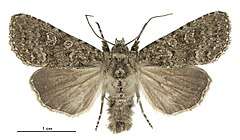Graphania omicron
| Graphania omicron | |
|---|---|
 | |
| Male | |
 | |
| Female | |
| Scientific classification | |
| Kingdom: | Animalia |
| Phylum: | Arthropoda |
| Class: | Insecta |
| Order: | Lepidoptera |
| Family: | Noctuidae |
| Genus: | Graphania |
| Species: | G. omicron |
| Binomial name | |
| Graphania omicron | |
| Synonyms | |
| |
Graphania omicron is a species of moth in the family Noctuidae. It is endemic to New Zealand. This species is classified as "At Risk, Naturally Uncommon" by the Department of Conservation.
Taxonomy
This species was described and illustrated by George Hudson in 1898 and named Melanchra omicron.[2] It was discovered by Albert Norris in Karori, Wellington.[2] In 1928 Hudson, thinking M. omicron was the same species as Aletia inconstans, discussed the it under the latter name in his book The Butterflies and Moths of New Zealand.[3] In 1939 Hudson reinstated M. omicron as a separate species.[4] The type specimen is missing and has not been found at Museum of New Zealand Te Papa Tongarewa.[3][5]
Description
Hudson described the species as follows:
The expansion of the wings is about 1 1⁄2 inches. The fore-wings are pale olive-green, mottled and striped with dull grey ; there is a double transverse line near the base, another at about one-fourth, and another at about one-half, passing between the orbicular and the reniform ; beyond this there are two indistinct shaded lines, and a terminal series of black marks ; the orbicular is large, almost circular, and sharply outlined in black ; the claviform is small and indistinct, and the reniform ill-defined, obscurely outlined in black towards the base. The hind-wings are brownish-grey, darker towards the termen.[2]
Distribution
This species is endemic to New Zealand.[1][6] Although regarded as being known only from Wellington,[5] Auckland Museum has specimens collected in Otago.[7] G. omicron has been recorded as occurring at Baring Head,[8] Titahi Bay,[9] Central Otago[10] and Otago Lakes.[11]
Biology and behaviour
This species is on the wing in November,[2] December and January.[12]
Host species and habitat
G. omicron has been recorded at raised shingle beach habitat.[8]
Conservation Status
This species has been classified as having the "At Risk, Naturally Uncommon" conservation status under the New Zealand Threat Classification System.[13]
References
| Wikimedia Commons has media related to Graphania omicron. |
| Wikispecies has information related to Graphania omicron |
- 1 2 "Graphania omicron (Hudson, 1898)". www.nzor.org.nz. Landcare Research New Zealand Ltd. Retrieved 2017-07-09.
- 1 2 3 4 Hudson, George Vernon (1898). New Zealand moths and butterflies (Macro-lepidoptera). London: West, Newman & co. p. 22. doi:10.5962/bhl.title.7912.
- 1 2 Dugdale, J. S. (1988). "Lepidoptera - annotated catalogue, and keys to family-group taxa" (PDF). Fauna of New Zealand. 14: 77. Retrieved 22 May 2018.
- ↑ Hudson, G. V. (1939). A supplement to the butterflies and moths of New Zealand. Wellington: Ferguson & Osborn Ltd. p. 400.
- 1 2 Patrick, Brian; Dugdale, John S. (2000). Conservation status of the New Zealand lepidoptera (PDF). Wellington, N.Z.: Department of Conservation, New Zealand. p. 24. ISBN 0478218672. OCLC 154670803.
- ↑ Gordon, Dennis P., ed. (2010). New Zealand inventory of biodiversity. Volume two. Kingdom animalia : chaetognatha, ecdysozoa, ichnofossils. Vol. 2. Christchurch, N.Z.: Canterbury University Press. p. 460. ISBN 9781877257933. OCLC 973607714.
- ↑ "Graphania omicron". www.aucklandmuseum.com. Retrieved 22 May 2018.
- 1 2 Crisp, Philippa (2011). "Baring Head ecological values" (PDF). www.gw.govt.nz. Retrieved 22 May 2018.
- ↑ "Graphania omicron". www.aucklandmuseum.com. Retrieved 22 May 2018.
- ↑ "Graphania omicron". www.aucklandmuseum.com. 22 November 2002. Retrieved 22 May 2018.
- ↑ "Graphania omicron". www.aucklandmuseum.com. 22 November 2002. Retrieved 22 May 2018.
- ↑ White, E. G. (1991). "The changing abundance of moths in a tussock grassland, 1962-1989, and 50-to 70-year trends" (PDF). New Zealand Journal of Ecology: 5–22.
- ↑ Hoare, R.J.B.; Dugdale, J.S.; Edwards,, E.D.; Gibbs, G.W.; Patrick, B.H.; Hitchmough, R.A.; Rolfe, J.R. (2017). "Conservation status of New Zealand butterflies and moths (Lepidoptera), 2015" (PDF). New Zealand Threat Classification Series. 20: 8.